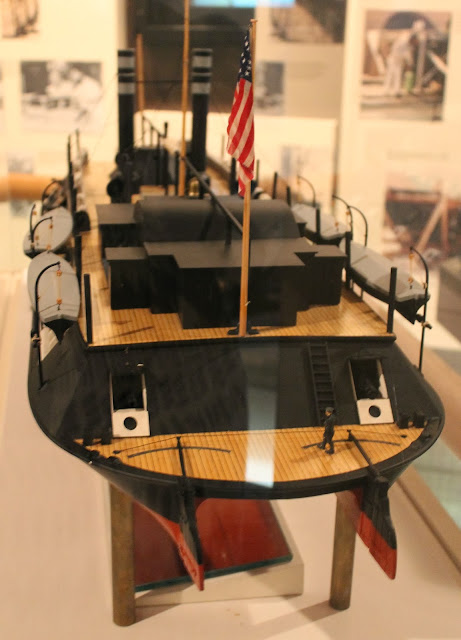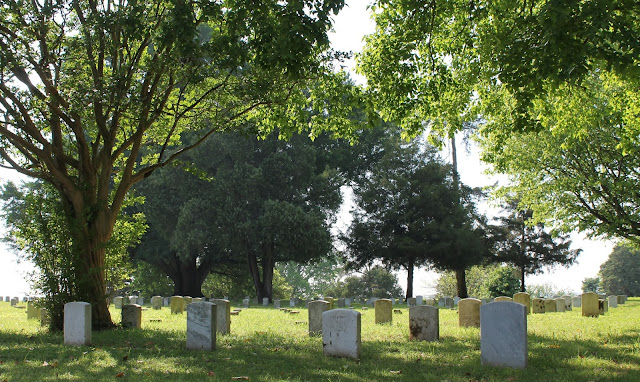We really enjoyed our time at the Vicksburg National Military Park. Two highlights of this military park are the U.S.S. Cairo Museum and the Vicksburg National Cemetery. We ended up having a blast spending more than an hour checking out these two unique places.
The U.S.S. Cairo Museum includes an outdoor exhibit of the actual Civil War ironclad river gunboat, U.S.S. Cairo, and a small indoor museum. The U.S.S. Cairo was sunk by the Confederate Army on December 12, 1862 in the Yazoo River. It was the first vessel in naval history to be sunk by an electronically detonated mine. Today it is the only survivor of the Mississippi River Squadron, which was a Union naval squadron. Back in 1964, the gunboat was raised containing a large number of artifacts left aboard by the sailors. What was most impressive is how well preserved the U.S.S. Cairo and its artifacts were after being underwater for 102 years.
The U.S.S. Cairo Museum includes an outdoor exhibit of the actual Civil War ironclad river gunboat, U.S.S. Cairo, and a small indoor museum. The U.S.S. Cairo was sunk by the Confederate Army on December 12, 1862 in the Yazoo River. It was the first vessel in naval history to be sunk by an electronically detonated mine. Today it is the only survivor of the Mississippi River Squadron, which was a Union naval squadron. Back in 1964, the gunboat was raised containing a large number of artifacts left aboard by the sailors. What was most impressive is how well preserved the U.S.S. Cairo and its artifacts were after being underwater for 102 years.






James Eads was the engineer who built the U.S.S. Cairo along with six other Union ironclad gunboats: St. Louis, Carondelet, Cincinnati, Louisville, Mound City and Pittsburgh. He named the U.S.S. Cairo after Cairo, Illinois.


While the U.S.S. Cairo was clearing mines on the Yazoo River the enemy lay in wait and electronically activated "torpedoes". The vessel sunk within 12 minutes without a loss of any lives. The sailors abandoned everything on board except for what they wore on their backs.

It was beautiful looking into the hull of this old ironclad.



We learned about the steam-driven propulsion used on the U.S.S. Cairo.


I found it really interesting that more than half the sailors stationed aboard this vessel were immigrants. Most of them had no sailing experience and learned their duties while on the job.



Look at the damage the pilothouse sustained.



The capstan was incredibly important. It was used to move guns on the gun deck, pull up the anchor and haul heavy lines.


Love the beauty of this old Civil War ironclad gunboat!

There were 13 heavy cannons aboard the U.S.S. Cairo. It took six men to man each gun. When the Cairo was recovered from its watery grave they found all but one cannon fully loaded.





I love the look of the exposed paddle wheels!


Looking at the rear of this vessel is quite impressive. It dwarfs the people inside and shows just how massive the U.S.S. Cairo was.



The damage sustained by the "torpedoes" is still evident on places like the back corner of the U.S.S. Cairo. Grateful this fine vessel was preserved so well under silt and mud at the bottom of the Yazoo River.

After investigating the actual U.S.S. Cairo in the outdoor exhibit we ventured inside the U.S.S. Cairo Museum. It is a very small museum which encompasses only one large room with an impressive amount of artifacts.

The U.S.S. Cairo was used as part of the Union's Anaconda Plan. That plan included blockading the Southern ports and advancing down the Mississippi River which would cut off all supply lines.

These early photos of Union ironclad river gunboats are amazing!


When the U.S.S. Cairo sank the sailors left everything behind. Their belongings were beautifully preserved inside the vessel and underwater for 102 years. Inside the U.S.S. Cairo Museum there is a large number of artifacts which take us back to a bygone era.








The kids really enjoyed checking out all of the artifacts since there were so many various kinds displayed. Since it is such a small museum the kids were free to wander on their own. As you can see Delaney was finished first and she decided to kick it on the stairs as we continued to check out the artifacts.




The military ammunition was quite interesting.

There was also a small video about the salvage and restoration of the Cairo. Braxton found it quite fascinating.



The U.S.S. Cairo Museum is well worth a visit!

Right next to the U.S.S. Cairo Museum is the beautiful Vicksburg National Cemetery. After the Civil War the United States Army located and exhumed over 300,000 Union veterans that were buried in the South. Since these Union soldiers died in the service of their country they were eligible to be re-interred in national cemeteries that had been established around the country. The Vicksburg National Cemetery was established in 1866 and the first burials began in 1867. There are 17,000 Union soldiers buried here and 13,000 of them are listed as "unknown". (Note: Headstones with a rounded top are those of the identified dead. Graves of the "unknown" are marked with a small square block.) More Civil War Union soldiers buried here than anywhere else in the nation. After the Spanish-American War another 1,300 individuals were buried here before this national cemetery closed for burials in May 1961.



A large part of the Vicksburg National Cemetery is dedicated to the United States Colored Troops. About 40% of the soldiers buried here are from the United States Colored Troops. There were 178, 895 men of color that enlisted in the Union Army. During the last two years of the Civil War, these good men served their country and fought valiantly for their freedom.


Throughout the Vicksburg National Cemetery there are signs with stanzas from the poem "The Bivouac of the Dead" by Theodore O'Hara. It is very fitting for these hallowed grounds. (I posted the entire poem below.)



Such a sea of good, honorable men who fought for their country.


"The Bivouac of the Dead" by Theodore O'Hara
The muffled drum's sad roll has beat
The soldier's last tattoo;
No more on Life's parade shall meet
That brave and fallen few.
On Fame's eternal camping-ground
Their silent tents to spread,
And glory guards with solemn round
The bivouac of the dead.
No rumor of the foe's advance
Now swells upon the wind;
Nor troubled thought of midnight haunts
Of loved ones left behind;
No vision of the morrow's strife
The warrior's dreams alarms;
No braying horn or screaming fife
At dawn shall call to arms.
Their shivered swords are red with rust,
Their plumed heads are bowed,
Their haughty banner, trailed in dust,
Is now their martial shroud.
And plenteous funeral tears have washed
The red stains from each brow,
And the proud forms, by battle gashed,
Are free from anguish now.
The neighing troop, the flashing blade,
The bugle's stirring blast,
The charge, the dreadful cannonade,
The din and shout, are past;
Nor war's wild notes, nor glory's peal
Shall thrill with fierce delight
Those breasts that nevermore shall feel
The rapture of the fight
Like the fierce Northern hurricane
That sweeps the great plateau,
Flushed with the triumph, yet to gain,
Come down the serried foe,
Who heard the thunder of the fray
Break o'er the field beneath,
Knew the watchword of the day
Was "Victory or death!"
Long had the doubtful conflict raged
O'er all that stricken plain,
For never fiercer fight had waged
The vengeful blood of Spain;
And still the storm of battle blew,
Still swelled the glory tide;
Not long, our stout old Chieftain knew,
Such odds his strength could bide.
Twas in that hour his stern command
Called to a martyr's grave
The flower of his beloved land,
The nation's flag to save.
By rivers of their father's gore
His first-born laurels grew,
And well he deemed the sons would pour
Their lives for glory too.
For many a mother's breath has swept
O'er Angostura's plain --
And long the pitying sky has wept
Above its moldered slain.
The raven's scream, or eagle's flight,
Or shepherd's pensive lay,
Alone awakes each sullen height
That frowned o'er that dread fray.
Sons of the Dark and Bloody Ground
Ye must not slumber there,
Where stranger steps and tongues resound
Along the heedless air.
Your own proud land's heroic soil
Shall be your fitter grave;
She claims from war his richest spoil --
The ashes of her brave.
Thus 'neath their parent turf they rest,
Far from the gory field,
Borne to a Spartan mother's breast
On many a bloody shield;
The sunshine of their native sky
Smiles sadly on them here,
And kindred eyes and hearts watch by
The heroes sepulcher.
Rest on, embalmed and sainted dead!
Dear is the blood ye gave;
No impious footstep here shall tread
The herbage of your grave;
Nor shall your glory be forgot
While Fame her record keeps,
For honor points the hallowed spot
Where valor proudly sleeps.
Yon marble minstrel's voiceless stone
In deathless song shall tell,
When many a vanquished ago has flown,
The story how ye fell;
Nor wreck, nor change, nor winter's blight,
Nor time's remorseless doom,
Can dim one ray of glory's light
That gilds your deathless tomb.

No comments:
Post a Comment